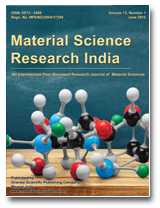Current Issue
Views: 16,335
Views: 164
3D Printing's Green Revolution: A Review of Usage of Sustainable and Recycled Polymers
Pages : 105-114The convergence of sustainability concerns and additive manufacturing technologies has sparked significant interest in the use of recycled plastics for 3D printing. This review paper examines the current state of research and practice in this rapidly evolving field. It explores the processes involved in recycling various types of plastics for 3D printing applications, with a focus on commonly used materials such as PLA and ABS. The review finds that while it is feasible to use recycled plastics in 3D printing, particularly in fused deposition modelling (FDM), the quality and consistency of the resulting products can vary significantly. Recycled PLA tends to show some degradation in mechanical properties, while recycled ABS generally maintains its properties better through the recycling process. Interestingly, recycled materials often produce smoother surface finishes in 3D printed objects. The paper also highlights the need for further research in areas such as standardization of recycling processes for 3D printing, long-term performance studies of products made from recycled materials, and life cycle assessments comparing recycled and virgin plastics in 3D printing contexts. Overall, this review underscores the potential of using recycled plastics in 3D printing as a significant step towards more sustainable manufacturing practices.
Punica granatum – based ternary metal oxide Nanoparticles: Degradation of Methylene Blue and Antimicrobial Study
Pages : 115-133The production of nanoparticles derived from plant extracts has attracted considerable attention due to their cost-effectiveness, eco-friendly nature, and effective performance in different applications such as wastewater treatment and biomedicine. The present research emphasizes the eco-friendly synthesis of a nano-hybrid structure consisting of punica granatum (PGE) extract with zinc, lead, and manganese (ZPM). It is designed for efficient degradation of Methylene blue (MB) in nano-hybrid water systems. Punica granatum incorporated Zinc, lead and manganese (PGE/ZPM) nanohybrid structure was characterized using various techniques including FTIR (Fourier-transform infrared spectroscopy), FESEM (Scanning electron microscopy) with elemental mapping, HRTEM (Transmission electron microscopy), XPS (X-ray photoelectron spectroscopy) XRD (X-ray diffraction), TGA (Thermogravimetric analysis) and UV-Vis spectroscopy. The study included a thorough investigation of the optimization parameters specifically analyzing the effects of pH, dye concentration and catalyst dosage. The results showed that under solar exposure, 83.68% of Methylene blue (MB) was removed within 3 hours. The degradation mechanism follows pseudo-first order kinetics and the highest rate of degradation of MB at pH 6.0 was determined to be k= 0.0159 min-1. The photocatalyst was reused for five cycles, showing only a minor decline in degradation effectiveness. Antibacterial effectiveness of PGE, ZPM and PGE/ZPM was also assessed against Staphylococcus aureus (S. aureus) and Escherichia coli (E. coli). In summary, the cost-effective and environmentally friendly method used to synthesize PGE/ZPM has proven to be a versatile photo-catalytic and antibacterial agent.
Investigation of Solubility Behavior, Data Correlations and Thermodynamic Study of Succinic Acid in Water + Methanol Mixtures at Various Temperatures
Pages : 134-140By using a gravimetric approach, the solubility of succinic acid in water, methanol, and water + methanol binary solvent was determined at temperatures between 305.15 and 313.15 K in the local atmosphere. The findings of the experiment demonstrated a positive correlation between temperature rise and succinic acid solubility. In order to better correlate and match the experimental results, the thermodynamic models van't Hoff and Apelblat were used. Additionally, the DFT investigation was conducted to look into how solvent-solute interactions affected solubility. In addition, the dissolving process's thermodynamic characteristics were computed, and the findings suggested that it was an entropy-driven, spontaneous, endothermic process.
Poly [(maleic acid)-co-(propane-1,2-diol)-ran- (citric acid)] for pH-Responsive Extended Drug Release
Pages : 141-150The Dean-Stark apparatus was used to synthesize poly[(maleic acid)-co-(propane-1,2-diol)-ran-(citric acid)] in xylene medium in presence of anhydrous FeCl3 catalyst. FTIR-spectrum, TGA, soil burial biodegradation test, molecular weights, solubility in common organic solvents, elemental analysis and hydrolytic degradation test were performed to characterize the synthesized co-polyester. Soil burial biodegradation study showed nearly complete miscibility of the co-polyester in soil within around 2 months. Hydrolytic degradation study in solutions of different pH values, at room temperature, showed that this co-polyester stayed practically intact in solutions of pH 1.2-6.0, but they steadily degraded in solutions of pH>7.0. Because of such pH-responsive degradation characteristics, this co-polyester was tried as a carrier of oral formulation for non-steroidal anti-inflammatory drugs. In simulated intestinal fluid, a constant rate of drug release (zero order) up to 10 hours from drug-loaded polymer matrix tablets was observed.
Design and Modelling of Human Body Temperature Detection Doors
Pages : 151-156The later Covid 19 widespread has raised concerns approximately existing security measures to control the spread of the malady through touch and contact. One of the security measures is wearing veils in open places and all over. In this paper, there's a savvy entryway that employments a machine learning show to track body temperature. The planned show can be utilized for any school, college, shopping center, in, loft entrance, etc. The result may be a cost-effective and solid strategy of utilizing Arduino, PIR sensor, and MLX90614 to construct a sound environment. The assessment of the proposed system is carried out in such a way that the body temperature of the person is checked by employing a non-contact temperature sensor (below 38ºC). This programmed entryway framework employments an infrared temperature sensor with an Arduino uno to associate sending temperature estimation information to a database. The microcontroller can peruse the estimation of the user's body temperature, in case the body temperature is typical, the programmed entryway will open without touching the handle. In this way, the spread of the transmission of the coronavirus can be minimized, since there's no contact with objects that individuals regularly utilize, to specific handles. In this venture, an endeavor was made to create a model-programmed temperature location framework.
 Material Science Research India An International Peer Reviewed Research Journal
Material Science Research India An International Peer Reviewed Research Journal



